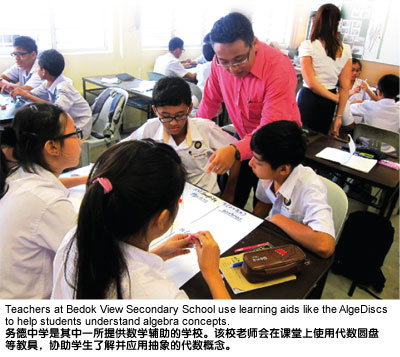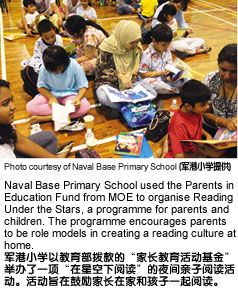|
 In Singapore, the Ministry of Education (MOE) is second only to the Ministry of Defence (MINDEF) in terms of annual government expenditure. For the Financial Year (FY) 2013, MOE has been allocated $11.635 billion, a mere $700 million less than MINDEF, which was allocated $12.335 billion. This figure also exceeded the $11.27613 billion MINDEF totalled in actual expenditure in FY 2011, and is the biggest ever sum given to education, 10.5 per cent higher than the $10.53 billion spent in the last financial year.
In Singapore, the Ministry of Education (MOE) is second only to the Ministry of Defence (MINDEF) in terms of annual government expenditure. For the Financial Year (FY) 2013, MOE has been allocated $11.635 billion, a mere $700 million less than MINDEF, which was allocated $12.335 billion. This figure also exceeded the $11.27613 billion MINDEF totalled in actual expenditure in FY 2011, and is the biggest ever sum given to education, 10.5 per cent higher than the $10.53 billion spent in the last financial year.
The strength of a country depends not only on military might; it hinges upon education, on producing skilled, independent, creative and innovative citizens to defend the country. In the past decade, the Singapore government has almost doubled its expenditure on education. In 2003, the education budget was $6.5 billion. In 2013, this figure is $11.6 billion, an increase of 78 per cent.
A financial injection of this magnitude directly benefits our students. All 500,000 of them have seen increasing amounts of government subsidy over the years. This financial year, their subsidies are projected to be, per student: $8,162 at the primary level; $10,845 at the secondary level; $13,888 at the junior college level; $11,966 for students in institutes of technical education; $14,804 for students in polytechnics; and $21,815 for undergraduates studying in publicly-funded universities.
Of the allocated $11.635 billion, $3.27 billion will be spent on our publicly-funded universities, an increase of $630 million (or 24 per cent) over last year’s $2.64 billion. This increase will largely go towards subsidising the increase in undergraduates this year, as well as overheads for research initiatives. The number of undergraduates this year is expected to be 73,600, an increase of 1,700 over last year.
The publicly-funded universities are the four autonomous universities: the National University of Singapore; the Nanyang Technological University; the Singapore Management University; and the Singapore University of Technology and Design, as well as the most recent institution to be upgraded to university status, the Singapore Institute of Technology (SIT).
In order to raise the university cohort participation rate from the current 27 per cent to the goal of 40 per cent by 2020 (which means an increase to 16,000 Singaporean undergraduates per cohort), the government has not only increased the number of places in the four autonomous universities and SIT, but it will also support full-time courses at SIM University (UniSIM). Even though UniSIM remains a private university, any student who enrols in its full-time programme will be entitled to the same amount of subsidy as is given to students from the other publicly-funded universities. As the number of undergraduates increases year on year, the government expenditure in this area is expected to rise in tandem.
The planned growth in the number of university graduates is in line with the government’s long-term development blueprint.
On 29 January 2013, Deputy Prime Minister Teo Chee Hean together with six other Members of Parliament unveiled the details of the Population White Paper at a press conference. One area the government is set to work on is increasing the number of PMET (Professional, Managerial, Executive and Technical) workers.
As the workforce becomes increasingly qualified it is predicted that by 2030 two thirds of adult Singaporeans (1.25 million people) will hold PMET jobs. This figure is an increase of 400,000 from the current number of 850,000, a 47 per cent growth. On the other hand, the number in non-PMET jobs is expected to fall by 24 per cent to 650,000 compared to the 850,000 today. We can only fulfil these predictions if we increase the number of graduates.
 A paragraph in the Population White Paper reads: “Many Asian cities are modernising rapidly, and catching up on us. Singapore must continue to develop and upgrade to remain a key node in the network of global cities, a vibrant place where jobs and opportunities are created. Our economy must stay ahead of other Asian cities, so that we can provide them with the high-end goods and services that they need but are not yet able to produce themselves.” A paragraph in the Population White Paper reads: “Many Asian cities are modernising rapidly, and catching up on us. Singapore must continue to develop and upgrade to remain a key node in the network of global cities, a vibrant place where jobs and opportunities are created. Our economy must stay ahead of other Asian cities, so that we can provide them with the high-end goods and services that they need but are not yet able to produce themselves.”
Singapore can only remain competitive if we have a high quality workforce.
Our businesses will need a workforce with the full range of skills, backgrounds and experiences that can kick-start high value-added merging sectors, and understand regional and international markets. Such a workforce can only be built by raising the educational level and quality of Singaporeans.
The Trends in International Mathematics and Science Study (TIMSS) conducted in 2011 published the results in Maths and Science of Grade 4 and Grade 8 students (i.e. Secondary 2) from 50 and 42 countries and economies respectively. Singapore ranked first in Primary 4 Maths and Secondary 2 Science, and second in Primary 4 Science and Secondary 2 Maths, behind Korea.
The Progress in International Reading Literacy Study (PIRLS) conducted in 2011 saw participation from Grade 4 students from 45 countries and economies. Singaporean students came in fourth. For countries for which the medium of examination is English, the mean score of Singaporean students was the highest, coming in ahead of Northern Ireland and the United States.
China did not take part in either assessment.
On 13 March 2013 when Minister for Education Heng Swee Keat spoke at the Committee of Supply Debate he referred to these international benchmarking studies. Singapore has achieved commendable results, even more so as less than four per cent of students fell below the “low” benchmark of competence across all grades and subjects. This is significantly better than what was achieved a decade ago, and far better than the international average of 12 to 27 per cent.
However, Mr Heng was still concerned about this small percentage of students who fell into the “low ability” group.
“One to four per cent is still too many for us,” he said, and pledged to do better. He went on to outline a set of measures to level-up our weaker students and those who come from disadvantaged backgrounds. These policies will comprehensively improve the chances for these children in a Master Plan of “Hope and Opportunity” that will help every child to succeed and leave no child left behind. These measures will kick in at the earliest levels, so no Singaporean child will lose out at the starting line. They will help every child, regardless of family background, to attend a quality kindergarten, and thereafter to build a strong foundation in the ten years of his or her primary and secondary education. This is especially important for students from disadvantaged backgrounds and for those who need more dedicated support.
“Our education system must always provide hope — and what is more, provide hope to all,” stressed Mr Heng.
These admirable policies include setting up 15 pilot kindergartens in the next three years in HDB heartlands. These kindergartens will provide a quality education that will be affordable to Singaporeans. This will give a boost to low-income families that cannot afford to send their children to a good pre-school. In the coming five years, the government will spend more than $3 billion on early childhood education.
“Parents who don’t earn a lot often neglect their child’s pre-school education. They are of the misconception that it is unimportant. Therefore we need to expand and strengthen our early childhood education in order to help the children from low-income families, and let them receive quality pre-school education,” said Mr Heng.
Additionally, more Student Care Centres will be set up in schools. These Centres will be staffed by professionals who will look after their charges while the parents are out at work. Currently, there are 80 Schools equipped with such Centres, responsible for caring for the students after classes. This number will increase in the future.
 The Learning Support Programmes for English and Mathematics, which were originally put in place for Primary 1 and 2 students who start primary school with weaker foundations in literacy and numeracy, will be expanded to help students all the way up to secondary school. These supplementary classes will have no more than ten students per class to ensure that each child receives sufficient attention. To this end, MOE will recruit another 600 teachers. The Learning Support Programmes for English and Mathematics, which were originally put in place for Primary 1 and 2 students who start primary school with weaker foundations in literacy and numeracy, will be expanded to help students all the way up to secondary school. These supplementary classes will have no more than ten students per class to ensure that each child receives sufficient attention. To this end, MOE will recruit another 600 teachers.
Similarly, the Opportunity Fund, which provides financial subsidies for immersion programmes and necessary educational purchases, saw its budget increase by $72 million. Schools that have more students from poor families will receive more money. Each secondary school is eligible to receive up to $275,000 from the Opportunity Fund and each primary school up to $150,000, which is a 40 per cent increase. Starting from this year, needy students in polytechnics may also apply for subsidies from the Opportunity Fund should they wish to go overseas for immersion programmes. An estimated 100,000 students from less well-to-do families stand to benefit from this scheme.
“Today, around 30 per cent of our economically active adults over the age of 50 do not have anything more than a Primary School education. Many find it very hard to upgrade or retrain for better jobs. In the future MOE will aim for every student to complete his or her secondary education and ideally go on to pursue a tertiary qualification as well. It is about providing the best opportunities for every child to succeed, regardless of their background and pace of development. Every child has the potential and power to succeed in school and in life, if he or she puts in the effort. Special attention should be given to those from disadvantaged backgrounds. This is about hope,” said Mr Heng.
Mr Heng quoted one participant in the current Singapore Conversation who said, “We need to groom Singaporeans who are confident yet humble and generous in heart; always seeking to learn and improve; dignified and respectful but also assertive in voicing their concerns in a sensible way.”
For those concerned about Singapore education, we will have to wait and see whether this can now happen.
Translated by: Lee Xiao Wen
|